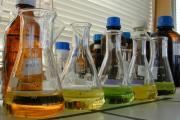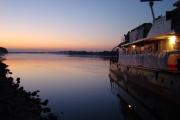Downloads
The JDS2, organized by the ICPDR, was likely the world's biggest river research expedition ever.
The JDS2 was officially launched on August 14, 2007 in Regensburg, Germany. In total, a distance of 2,600 km of the Danube River was assessed, 2,415 km of which were completed by the three boats of the JDS2 travelling from Kelheim, Germany, through 10 countries, to the Danube Delta in Romania and Ukraine until late September. The JDS2 successfully sampled 96 sites on the Danube River and 28 on its tributaries. Ten cities were also visited to increase public awareness.
Its main goal was to produce highly comparable and reliable information on water quality and pollution for the entire Danube River and many of its tributaries. Water pollution is a major problem in the Danube Basin. Danube governments need to make sound decisions about what future measures they will take to reduce Danube pollution and improve ecological health. This will help them to meet their obligations to implement the ‘Danube River Protection Convention', which they signed in 1994, as well as the `EU Water Framework Directive´.
The JDS2 follows up on the work done during the first Joint Danube Survey (JDS1) in 2001. The JDS1 had a mix of positive and negative results. On the positive, it found high levels of biodiversity and rare species. On the negative, results showed areas where organic and microbiological pollution, heavy metals, oil from ships, pesticides and chemicals were of concern. The JDS2 expanded on the JDS1 by adding new parameters and sampling locations.
The expedition attracted significant international cooperation from all Danube countries from Germany to Ukraine, including EU and non-EU members. The full-time International Team travelling the entire length of the Danube included 18 scientists who used three boats donated from different countries and institutions. Teams of national scientists also helped with sampling and testing on river stretches within their countries.
Some of the actual scientific testing took place en route, from analyzing water samples in the JDS2 research ship laboratory to electro-fishing along the Danube's banks. Other samples were sent to laboratories throughout Europe for testing. Significant support was provided by private sector companies. Finally, local authorities and media living near the Danube helped raise awareness about the Danube and the need to participate in making it healthy.
See the following stories:
- The JDS2 Boat Expedition: nobody said it would be easy (Danube Watch 3/2007)
- The Danube Test: New Techniques and Technologies
Online you can view JDS2 results, stories and pictures. This special ICPDR website also includes Fact Sheets, leaflets, poster, maps, photographs and short stories from people taking the cruise, presenting a travel blog of interesting and timely experiences from on board the ships.
You can view or download the Fact Sheets on this page. There are seven Fact Sheets in all. An overall summary of the JDS2 can be found in 'Factsheet JDS2' in seven languages. Other Fact Sheets, most in English and German, relate to the JDS2 Route, Partners, Scientific Team, as well as Danube Pollution and Monitoring. We also encourage you to download the leaflets and posters.



















